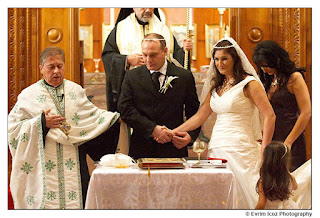Jeff--Saturday
I'm not in a particularly good mood today. A condition I'm certain I share with many these days. But I don't want to write about something that might leave a bad taste in anyone's mouth--especially with Stan having expounded so eloquently upon the wonders of Marmite in his Thursday post.
So, I decided to write about one of the happiest days in most folk's life. Their wedding day. But not just any wedding day, a
Greek wedding among Mykonians on their home island of Mykonos. Traditions there are somewhat different than in big city Athens, but no
matter where a Greek wedding is held, I can assure you the party is always a
blast.
Traditionally when two Mykonians marry, several hours before
the service the bride and groom go to their respective parents’ homes to gather
with family and friends who’ve come to help prepare them for the big day. Amid a lot of singing, drinking, and nuts (meant
to be the edible kind, symbolizing fertility) the party begins.
The groom, accompanied by an entourage including musicians, arrives
at the church first, to cool his heels waiting for his bride to show. Tradition always has her arriving
late—possibly to give her groom a chance to sober up.
The bride and her family also arrive with musicians, generally
playing a santouri dulcimer and an accordion or two. They stop in front of the
groom as the bride’s parents turn their daughter over to her soon-to-be husband. Then it’s on to the ceremony.
All organized faiths offer more than simply words when
asking souls to exchange lifetime vows; centuries-old symbols and rituals are employed
to impress upon the couple the seriousness of their commitment.
Symbolic of all Greek Orthodox weddings are a bible,
almonds, wine cup and decanter, and two stefana—bridal crowns of starched white
leather, orange blossoms and ivy joined together by a single silver ribbon (or
a variation thereof)—all on a small table.
And everyone attending a Greek wedding has some traditional
part to play.
The priest reads from the wedding service as he performs the
expected traditional rites, such as touching the wedding bands, and later the stefana,
three times to the foreheads of the bride and groom.
The koumbarous and koumbara, honors akin to, but far more
significant than, best man and bridesmaid, are charged with switching wedding
bands three times from the couple’s left ring fingers—where worn when engaged—to
their right where worn when married, and with holding the stefana above the
couple’s heads waiting for the moment to switch them three times between bride
and groom.
The bride has the most whimsical, and some say “instructive,”
tradition. Near the end of the service
the priest reads, “The wife shall fear her husband,” at which point the bride
brings to life the expression, “It’s time to put your foot down,” by stepping
on her man’s foot to the great joy and cheers of all, especially chiropodists.
The guests play their parts after the couple drinks three times
from the common cup and begin their ceremonial first steps together as husband
and wife. The bride, groom, koumbaroi,
and priest circle the small table three times amid a barrage of rice and, in
Mykonos tradition, powerful whacks to the groom’s back by his buddies.
Then its time for greetings of “kalo riziko,” “na zesete,” and “vion
anthosparton” wishing the couple a marriage of “good roots,” “long life,” and
“full of flowers,” and off to the party venue. The only ones who don’t head straight to the
party are the bride and groom. They stop
at their new home to change clothes.
By the way, don’t worry if your name isn’t on the guest
list, because as long as you’re with an invited guest you’re in. That sort of thing is expected at a Greek wedding
where there’s always more than enough food, drink, and room for one more.
There’s also music playing while the guests wait for the
bride and groom to arrive, and as soon as they do, the tune switches to one that
lets everyone know the couple is here. Amid
a roar of applause and shouts of good wishes, they make their way through a phalanx
of hugs and kisses to the dance floor.
With a nod of the bride’s head, the band begins playing the ballos,
the traditional six-step dance of the Cycladic islands, one of the most
beautiful to watch, and the first done at any true Mykonian wedding. Once they are dancing the party is officially
underway, and the couple is joined in sequence by their parents, koumbaroi,
immediate family, and guests until a full line of partiers is dancing in the syrto
style that symbolizes the essence of Greek life to so much of the world. Later will come the kalamatiano, arguably
Greece’s most popular dance and one played at every Greek wedding.
I will not mention the food. Just think enormous…and triple
your thought.
Tonight is a time to let loose and worry about nothing more
than passing out before the last guest departs, which will be long after the
cake cutting and fireworks display. And
don’t worry about having to find your way home in the dark. The sun will be up
by then.
Vion anthosparton, y'all!







.jpeg)















What a lovely diversion from pandemics and protests! We have yet to be invited to a Greek wedding and hope one day to experience such festivities first hand.
ReplyDeleteOh, my, I'm exhausted just from reading about it (and, no, that's not a comment upon your excellent prose). I must be getting old...
ReplyDelete